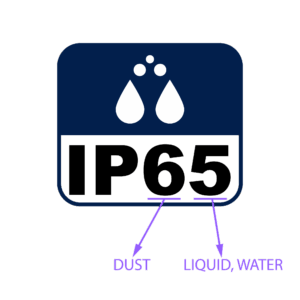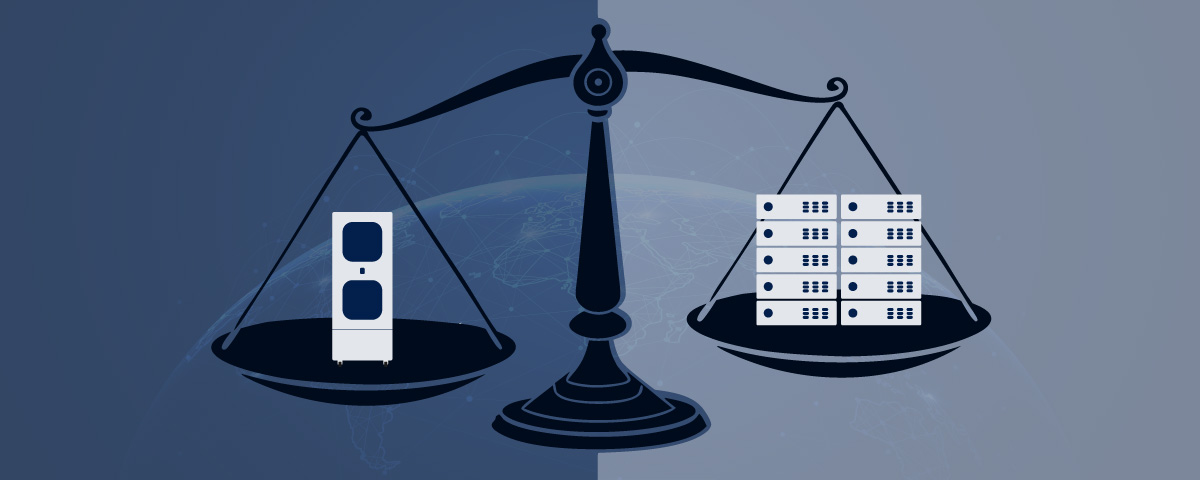What does IP65 mean and why it matters?
In the world of IT infrastructure, especially when deploying in unpredictable or harsh environments, protection is everything. Whether you’re setting up at a mine site, a rural school, or a telecom tower in the middle of nowhere, your equipment is exposed to the elements, and failure isn’t an option.
That’s where IP ratings come in.
If you’ve ever seen a product labelled IP65, you might have wondered what that actually means, and whether it really matters. Spoiler: it does.
In this blog, we’ll explain what IP65 is, why it’s important for IT deployments (especially at the edge), and how Zella DC’s micro data centres are designed to meet this demanding standard.
What is an IP rating?
IP stands for Ingress Protection, and it’s a globally recognised standard (IEC 60529) used to classify the level of protection an enclosure provides against solids and liquids, like dust and water.
 An IP rating has two digits:
An IP rating has two digits:
- The first digit indicates protection against solids (like dust and dirt).
- The second digit indicates protection against liquids (like rain or hose water).
So, what does IP65 mean?
- 6 = Dust-tight. Complete protection from dust ingress.
- 5 = Water jet resistant. Protection from water jets from any direction.
In short, an IP65-rated enclosure is sealed tightly enough to prevent any dust from entering and can withstand powerful jets of water — making it ideal for outdoor and industrial environments.
Why IP65 matters for outdoor data centre and IT deployments
Most IT equipment was never designed to live outside. It thrives in climate-controlled server rooms, not in dusty mine sites, tropical downpours, or 40-degree summers.
That’s why IP ratings are critical. Here’s what your infrastructure could be exposed to in an outdoor or remote environment:
- Dust and fine particles that clog filters and fans
- Water ingress from rain, humidity, or cleaning
- Salt air in coastal or marine environments
- Extreme heat or cold
- Physical contaminants like insects or animals
Failure to protect against these can result in:
- Data loss
- Network downtime
- Frequent maintenance
- High equipment replacement costs
An IP65-rated enclosure helps eliminate these risks, ensuring business continuity, especially in edge computing environments where downtime can’t be easily resolved.
Zella Pro and Zella Outback: IP65-rated micro data centres
At Zella DC, we build micro data centres that are made to thrive in extreme environments, and both our indoor and outdoor solutions meet IP65 standards.
Zella Pro: Indoor use with extra protection
- Designed for indoor deployments but with an IP65 rating to ensure maximum protection.
- Suitable for dusty warehouses, unsealed buildings, remote offices, and indoor industrial sites.
- Sealed enclosure keeps out particles and protects against water spray or cleaning processes.
- Internal climate control to maintain optimal conditions regardless of the external environment.
Zella Outback: Outdoor-ready and rugged
- Purpose-built for outdoor edge computing with IP65-rated construction.
- Waterproof, dust-proof, UV-resistant, and vandal-resistant.
- Includes enhanced fireproofing, insulation, and remote access controls.
- Used in mining operations, telecom towers, remote education sites, and critical infrastructure.
- Delivered pre-configured and tested — just connect power and go.
Whether you’re placing your infrastructure in a metro facility or at the edge of a desert, IP65-rated Zella DC micro data centres are designed to keep your operations running without compromise.
IP ratings explained: how much protection do you really need?
To understand how robust IP65 is, here’s how it stacks up against other common IP ratings:
| IP Rating | Solids Protection | Water Protection | Common Use Cases |
|---|---|---|---|
| IP44 | Tools and wires | Water spray | Standard indoor enclosures |
| IP54 | Limited dust | Light water spray | Light-duty outdoor/warehouse applications |
| IP65 | Dust-tight | Water jet resistant | Heavy-duty outdoor or edge environments |
| IP67 | Dust-tight | Submersion up to 1m | Flood zones or submerged applications |
IP65 strikes a balance between maximum protection and practical deployment, it’s suitable for most outdoor scenarios without requiring expensive submersion-proofing.
IP65 vs NEMA ratings: what’s the difference?
If you’re used to working with NEMA ratings (common in the US), you might be wondering how IP65 compares.
While IP and NEMA ratings come from different standards, IP from the IEC (international) and NEMA from the US, they both serve a similar purpose: to define how well an enclosure protects against environmental hazards like dust and water.
Although not identical, IP65 is roughly equivalent to NEMA 4.
| Rating | Dust Protection | Water Protection | Outdoor Use | Notes |
|---|---|---|---|---|
| IP65 | Dust-tight (6) | Water jets from any direction (5) | ✅ | IEC standard, widely used internationally |
| NEMA 4 | Dust-tight | Hose-directed water, splashing | ✅ | Also includes protection against icing |
Key differences:
- NEMA 4 includes some protection against corrosion and ice formation, which IP65 doesn’t specify.
- IP ratings are only focused on ingress protection, while NEMA includes construction and durability considerations.
For most practical outdoor and industrial applications, an IP65-rated enclosure meets or exceeds the protection you’d get from a NEMA 4-rated one.
It’s not just about weatherproofing — it’s about uptime
When you’re deploying infrastructure in remote or unmanned locations, every layer of protection counts. An IP65 rating isn’t just a number, it’s about:
- Reducing maintenance and site visits
- Preventing data and operational losses
- Protecting critical systems from environmental risk
- Ensuring your infrastructure works — every time, without fail
And with edge computing rapidly expanding into more rugged, remote, and diverse environments, choosing an enclosure that meets IP65 or higher isn’t a luxury. It’s a must.
If your IT infrastructure is going anywhere outside a sealed, controlled room, you need to think about environmental protection. An IP65 rating ensures that your equipment can withstand real-world conditions, from dust storms to driving rain.
At Zella DC, both our Zella Pro and Zella Outback micro data centres are built to IP65 standards, giving you peace of mind, whether you’re deploying in an office, on a mountaintop, or in the middle of the outback.






